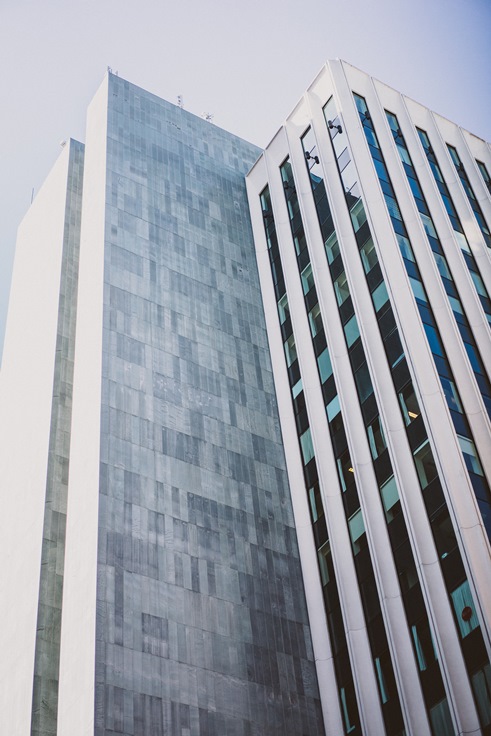Trappen van Vergelijking – What’s The Tallest Tower? Posted by Sten on Dec 19, 2016 in Dutch Grammar, Dutch Language, Dutch Vocabulary
Big. Bigger. Biggest. Enthusiastic. More enthusiastic. Most enthusiastic. We all know these forms, these trappen van vergelijking (“stairs of comparison” – degrees of comparison). How do they look in Dutch? Find out here.
The basics
There are three degrees of comparison: positive (full, great, wide), comparative (fuller, greater, wider) and superlative (fullest, greatest, widest). Easy! This is the same in Dutch, however with different names:
positive = stellende trap (stating stair) / positief
comparative = vergrotende trap (enlarging stair) / comparatief
superlative = overtreffende trap (exceeding stair) / superlatief
As you can see, there are the proper Dutch forms, but also the ones we already know in English. Both are fine. The positive is used to express the state of a noun by using a adjective (“stating stair”). The comparative is used to compare between nouns and point out those that are larger than the other in the quality of the adjective (“enlarging stair”). The superlative is used to point out the noun with most of the quality of the adjective (“exceeding stair”). Sounds complicated, but you get the point!
So, what do these look like in Dutch? The forms look very similar to English, so it is not too difficult! Let’s start with the stellende trap.
De stellende trap
De stellende trap is an easy one. It is just an adjective that states something about an object, in the example above it is the fact that the tower is tall. Nothing special here – piece of cake!
Some examples:
Het huis is klein. (The house is small.)
De wachtkamer is vol. (The waiting room is full.)
Het is een normale dag. (It is a normal day.)
De vergrotende trap
De vergrotende trap becomes more interesting. In the example above, you can see the construction hoger dan (taller than). Remember: dan is always used in the comparative, in the vergrotende trap. If you see hoger als, then you found a mistake! It is one of the more frequent mistakes made in Dutch, also by the Dutch. Only where the compared nouns are equal, als is used, for example: Deze toren is zo hoog als de Euromast in Rotterdam. (This tower is as tall as the Euromast in Rotterdam.) However, if you put a niet in that sentence, you get a difference in height between the towers: Die toren is niet zo hoog als de Euromast (That tower is not as tall as the Euromast) – and your mind may then expect dan. But of course, it has to be als here!
You can make a vergrotende trap by taking the adjective + er – mooier (more beautiful), leuker (nicer), much the same as in English. In words ending on an -e, you just add an r, of course: oranjer (more orange).
Anyway, some examples of de vergrotende trap:
Kees is kleiner dan Sara. (Kees is shorter than Sara.)
Het is makkelijker om een vierkant te tekenen dan een cirkel. (It is easier to draw a square than a circle.)
Drie plus drie is meer dan twee plus twee. (three plus three is more than two plus two.)
De overtreffende trap
The overtreffende trap is, again, pretty much the same as in English. You take the adjective + st – mooist (most beautiful), leukst (nicest). In English, “more” and “most” are used for words where there would be clear pronunciation issues by just adding “-st” (think: beautifullest, patheticst). Such problems also occur in Dutch: enthousiast, enthousiaster, meest enthousiast (because enthousiastst would just be unnecessarily difficult). The same for meest logisch (because logischst is crazy!) So here, you can use meest + stellende trap.
Cases where meest + stellende trap are used are the following:
- Difficult to pronounce, words ending with -de, -isch, -sd, -sk of -st.
- To emphasize something: Ik ben toch echt het méést betrokken (I actually really am the most involved).
- Where a voltooid deelwoord (a perfect form) is used as an adjective:
- brood is het meest geliefde middageten onder jongeren (bread is the most popular lunch among young people);
- Dit is het meest besproken boek in de laatste tijd (This is the most discussed book recently).
As you can see, sometimes it is up to you whether you use meest or whether you just add -st at the end of the word. For shorter and simpler words, you should however always just use -st at the end!
Examples:
Rihanna is tegenwoordig de populairste zangeres. (Rihanna is the most popular singer at the moment.)
Het kookmes is het scherpst. (The chef’s knife is the sharpest.)
In het gezin is de oude man het meest paranoïde. (In this family, the old man is the most paranoid.)
Special cases
Special cases always exist, unfortunately. Below are some that you will encounter a lot, so make sure you know them!
| stellende trap / positief | vergrotende trap / comparatief | overtreffende trap / superlatief | English form |
| veel | meer | (het) meest | much – more – (the) most |
| weinig | minder | (het) minst | little – less – (the) least |
| graag | liever | (het) liefst | glad – gladder – (the) gladdest |
| goed | beter | (het) best | good – better – (the) best |
Any questions? Any additions to the list of special cases? How does it work in your language? Let me know in the comments below!

Build vocabulary, practice pronunciation, and more with Transparent Language Online. Available anytime, anywhere, on any device.
About the Author: Sten
Hi! I am Sten, both Dutch and German. For many years, I've written for the German and the Dutch blogs with a passion for everything related to language and culture. It's fascinating to reflect on my own culture, and in the process allow our readers to learn more about it! Besides blogging, I am a German-Dutch-English translator, animator and filmmaker.






